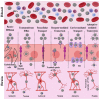Emerging Applications of Nanotechnology in Healthcare Systems: Grand Challenges and Perspectives
- PMID: 34451803
- PMCID: PMC8401281
- DOI: 10.3390/ph14080707
Emerging Applications of Nanotechnology in Healthcare Systems: Grand Challenges and Perspectives
Abstract
Healthcare, as a basic human right, has often become the focus of the development of innovative technologies. Technological progress has significantly contributed to the provision of high-quality, on-time, acceptable, and affordable healthcare. Advancements in nanoscience have led to the emergence of a new generation of nanostructures. Each of them has a unique set of properties that account for their astonishing applications. Since its inception, nanotechnology has continuously affected healthcare and has exerted a tremendous influence on its transformation, contributing to better outcomes. In the last two decades, the world has seen nanotechnology taking steps towards its omnipresence and the process has been accelerated by extensive research in various healthcare sectors. The inclusion of nanotechnology and its allied nanocarriers/nanosystems in medicine is known as nanomedicine, a field that has brought about numerous benefits in disease prevention, diagnosis, and treatment. Various nanosystems have been found to be better candidates for theranostic purposes, in contrast to conventional ones. This review paper will shed light on medically significant nanosystems, as well as their applications and limitations in areas such as gene therapy, targeted drug delivery, and in the treatment of cancer and various genetic diseases. Although nanotechnology holds immense potential, it is yet to be exploited. More efforts need to be directed to overcome these limitations and make full use of its potential in order to revolutionize the healthcare sector in near future.
Keywords: cancer; drug delivery; gene therapy; genetic disorders; healthcare; nanosystems; nanotechnology.
Conflict of interest statement
The authors declare no conflict of interest.
Figures
Similar articles
-
Theranostics Aspects of Various Nanoparticles in Veterinary Medicine.Int J Mol Sci. 2018 Oct 24;19(11):3299. doi: 10.3390/ijms19113299. Int J Mol Sci. 2018. PMID: 30352960 Free PMC article. Review.
-
Nanotherapeutics: An insight into healthcare and multi-dimensional applications in medical sector of the modern world.Biomed Pharmacother. 2018 Jan;97:1521-1537. doi: 10.1016/j.biopha.2017.11.026. Epub 2017 Nov 21. Biomed Pharmacother. 2018. PMID: 29793315 Review.
-
Recent advances in DNA nanotechnology for cancer detection and therapy: A review.Int J Biol Macromol. 2025 May;307(Pt 4):142136. doi: 10.1016/j.ijbiomac.2025.142136. Epub 2025 Mar 17. Int J Biol Macromol. 2025. PMID: 40107552 Review.
-
Nanosize drug delivery system.Curr Pharm Biotechnol. 2013;14(15):1221. doi: 10.2174/138920101415140804121008. Curr Pharm Biotechnol. 2013. PMID: 25106648
-
Cancer Nanotechnology: Opportunities for Prevention, Diagnosis, and Therapy.Methods Mol Biol. 2017;1530:3-12. doi: 10.1007/978-1-4939-6646-2_1. Methods Mol Biol. 2017. PMID: 28150193 Review.
Cited by
-
Neuro-nanotechnology: diagnostic and therapeutic nano-based strategies in applied neuroscience.Biomed Eng Online. 2023 Jan 2;22(1):1. doi: 10.1186/s12938-022-01062-y. Biomed Eng Online. 2023. PMID: 36593487 Free PMC article. Review.
-
Recent Updates on Diverse Nanoparticles and Nanostructures in Therapeutic and Diagnostic Applications with Special Focus on Smart Protein Nanoparticles: A Review.ACS Omega. 2024 Oct 10;9(42):42613-42629. doi: 10.1021/acsomega.4c05037. eCollection 2024 Oct 22. ACS Omega. 2024. PMID: 39464472 Free PMC article. Review.
-
Editorial: State-of-the-art rational nanodesign: from screening to theranostics and from bench to clinic.Front Pharmacol. 2023 May 17;14:1210185. doi: 10.3389/fphar.2023.1210185. eCollection 2023. Front Pharmacol. 2023. PMID: 37266141 Free PMC article. No abstract available.
-
Nanotechnology and CRISPR/Cas-Mediated Gene Therapy Strategies: Potential Role for Treating Genetic Disorders.Mol Biotechnol. 2024 Oct 24. doi: 10.1007/s12033-024-01301-8. Online ahead of print. Mol Biotechnol. 2024. PMID: 39446301 Review.
-
Effects of metal oxide nanoparticles on healthy and psoriasis-like human epidermal keratinocytes in vitro.Arch Toxicol. 2024 Nov;98(11):3689-3711. doi: 10.1007/s00204-024-03848-6. Epub 2024 Aug 26. Arch Toxicol. 2024. PMID: 39186148
References
-
- Hobson D.W. Intracellular Delivery III. Springer; Berlin/Heidelberg, Germany: 2016. The commercialization of medical nanotechnology for medical applications; pp. 405–449.
-
- Agarwal H., Kumar S.V., Rajeshkumar S. A review on green synthesis of zinc oxide nanoparticles–An eco-friendly approach. Resour. Effic. Technol. 2017;3:406–413. doi: 10.1016/j.reffit.2017.03.002. - DOI
-
- Bogutska K., Sklyarov Y.P., Prylutskyy Y.I. Zinc and zinc nanoparticles: Biological role and application in biomedicine. Ukr. Bioorg. Acta. 2013;1:9–16.
Publication types
LinkOut - more resources
Full Text Sources




